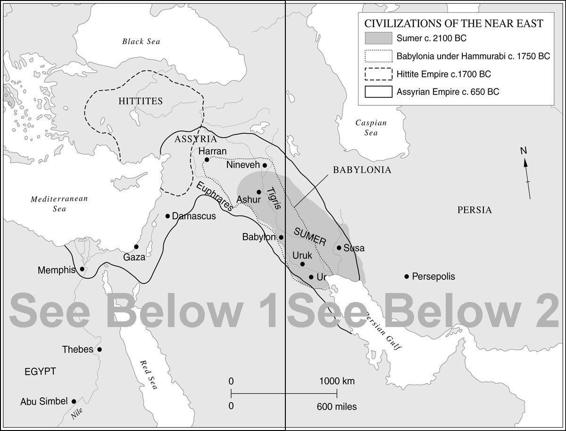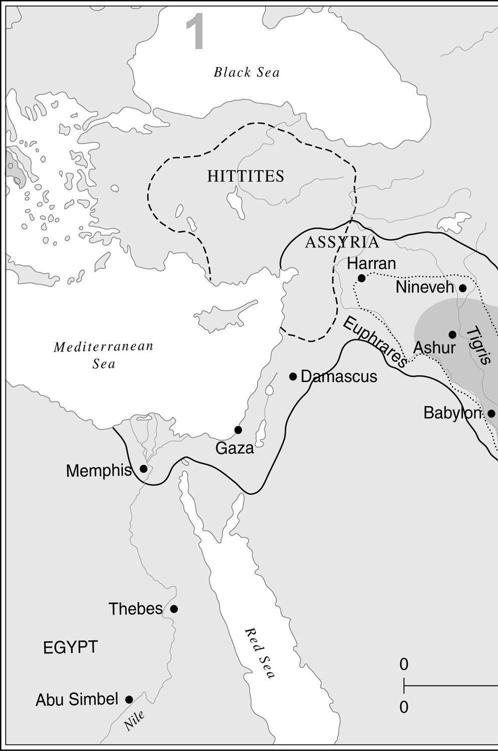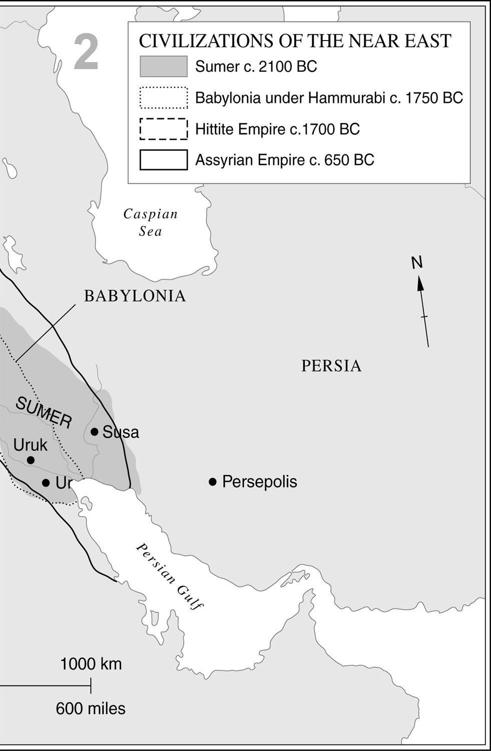The New Penguin History of the World (32 page)
Read The New Penguin History of the World Online
Authors: J. M. Roberts,Odd Arne Westad

Once again, the starting-point is a migration. On the high plateau which is the heart of modern Iran there were settlements in 5000
BC
, but the word ‘Iran’ (which does not appear until about
AD
600) in its oldest form
means ‘land of the Aryans’ and it is somewhere around 1000
BC
, with an irruption of Aryan tribes from the north, that the history of the Persian empire begins. In Iran, as in India, the impact of the Aryans was to prove ineffaceable and founded a long-enduring tradition. Among their tribes two – especially vigorous and powerful – have been remembered further west by their biblical names as the Medes and Persians. The Medes moved west and north-west to Media; their great age came at the beginning of the sixth century, after they had overthrown Assyria, their neighbour. The Persians went south towards the Gulf, establishing themselves in Khuzistan (on the edge of the Tigris valley and in the old kingdom of Elam) and Fars, the Persia of the ancients.
Oral tradition preserves a story of legendary kings more important for the light it throws on later Persian attitudes to kingship than as history. It was none the less from the Persian dynasty of the Achaemenids that there descended the first king of a united Persia – anachronistic though this term is. He was Cyrus, the conqueror of Babylon. In 549
BC
he humbled the last independent king of the Medes and thenceforth the boundaries of conquest rolled outwards, swallowing Babylon and advancing through Asia Minor to the sea, dropping down into Syria and Palestine. Only in the east (where he was eventually killed fighting the Scythians) did Cyrus find it difficult to stabilize his frontiers, though he crossed the Hindu Kush and set up some sort of supremacy over the region of Gandhara, north of the Jhelum.
This was the largest empire the world had seen until that time. Its style was different from its predecessors; the savagery of the Assyrians seems muted. At least brutality was not celebrated in official art and Cyrus was careful to respect the institutions and ways of his new subjects. The result was a diverse empire, but a powerful one, commanding loyalties of a kind lacking to its predecessors. There are some notable religious symptoms: the protection of Marduk was solicited for Cyrus’s assumption of the Babylonian kingship and at Jerusalem he launched the rebuilding of the Temple. A Jewish prophet saw in his victories God’s hand, named him the Lord’s anointed and gloated over the fate of the old enemy, Babylon:
‘
Let now the astrologers, the stargazers, the monthly prognosticators, stand up, and save thee from these things that shall come upon thee.’
Isaiah 17: 13
Cyrus’s success owed much to the material resources of his kingdom. It was rich in minerals, above all in iron, and in the high pastures of the valleys lay a great reserve of horses and cavalrymen. Yet it is impossible to resist the conclusion that sheer personal ability also counted for much; Cyrus lives as a world-historical figure, recognized as such by other would-be conquerors who were to strive in the next few centuries to emulate him. He based his government upon provincial governors who were the forebears of the later Persian satraps, and required from his subject provinces little beyond tribute – usually in gold, which replenished the treasuries of Persia – and obedience.



Thus began the empire which, though with setbacks aplenty, provided for nearly two centuries a framework for the Near East, sheltering a great cultural tradition which grew to nourish itself both from Asia and Europe. Large areas knew longer periods of peace under it than they had for centuries and it was in many ways a beautiful and gentle civilization. Greeks had already been told by Herodotus that the Persians loved flowers and there are many things we could do without more easily than the tulip, which we owe to them. Cyrus’s son added Egypt to the empire; yet he died before he could deal with a pretender to the throne whose attempts encouraged Medes and Babylonians to seek to recover their independence. The restorer of Cyrus’s heritage was a young man who claimed Achaemenid descent, Darius.
Darius (who reigned 522–486) did not achieve all he wished. His work, none the less, rivalled that of Cyrus. His own inscription on the monument recording his victories over rebels may be thought justified by what he did: ‘I am Darius the Great King, King of Kings, King in Persia’, a recitation of an ancient title whose braggadocio he adopted. In the east the boundaries
of the empire were carried further into the Indus valley. In the west they advanced to Macedonia, though they were checked there, and in the north Darius failed, as Cyrus before him, to make much headway against the Scythians. Inside the empire a remarkable work of consolidation was undertaken. Decentralization was institutionalized with the division of the empire into twenty provinces, each under a satrap who was a royal prince or great nobleman. Royal inspectors surveyed their work and their control of the machine was made easier by the institution of a royal secretariat to conduct correspondence with the provinces, and Aramaic, the old lingua franca of Assyrian empire, became the administrative language. It was well adapted to the conduct of affairs because it was not written in cuneiform but in the Phoenician alphabet. The bureaucracy rested on better communications than any yet seen, for much of the provincial tribute was invested in road-building. At their best these roads could convey messages at 200 miles a day.
A monument to this imperial achievement was to have been a great new capital at Persepolis, where Darius himself was buried in a rock tomb cut into the cliff face. Intended as a colossal glorification of the king, it remains impressive even when it seems pompous. Persepolis was in the end a collective creation; later kings added their palaces to it and embodied in it the diversity and cosmopolitanism of the empire. Assyrian colossi, man-headed bulls and lions guarded its gates as they had done those of Nineveh. Up its staircases marched stone warriors bearing tribute; they are a little less mechanical than the regimented Assyrians of earlier sculpture, but only a little. The decorative columns recall Egypt, but it is an Egyptian device transmitted through Ionian stone-cutters and sculptors. Greek details are to be found also in the reliefs and decoration and a similar mixture of reminiscences is to be found in the royal tombs not far away. They recall the Valley of the Kings in their conception while their cruciform entrances speak of something else. Cyrus’s own tomb, at Pasargadae, had also been marked by Greek design. A new world is coming to birth.
These monuments fittingly express the continuing diversity and tolerance of Persian culture. It was one always open to influence from abroad and would continue to be. Persia took up not only the language of those it conquered, but also sometimes their ideas. Vedic and Persian religion mingled in Gandhara, where stood the Indian city the Greeks called Taxila, but both, of course, were Aryan. The core of Persian religion was sacrifice and centred on fire. By the age of Darius the most refined of its cults had evolved into what has been called Zoroastrianism, a dualist religion accounting for the problem of evil in terms of the struggle of a good with an evil god. Of its prophet, Zoroaster, we know little, but it seems that
he taught his disciples to uphold the cause of the god of light with ritual and moral behaviour; ahead lay a messianic deliverance, the resurrection of the dead and life everlasting after judgement. This creed spread rapidly through western Asia with Persian rule, even though it was probably never more than the cult of a minority. It would influence Judaism and the oriental cults which were to be part of the setting of Christianity; the angels of Christian tradition and the notion of the hellfire which awaited the wicked both came from Zoroaster.
It is too early to speak of the interplay of Asia and Europe, but there are few more striking examples of the interplay of reciprocal influences which marks the end of the ancient world. We can mark an epoch. Right across the Old World, Persia suddenly pulled peoples into a common experience. Indians, Medes, Babylonians, Lydians, Greeks, Jews, Phoenicians, Egyptians were for the first time all governed by one empire whose eclecticism showed how far civilization had already come. The era of civilization embodied in distinct historical entities was over in the Near East. Too much had been shared, too much diffused for the direct successors of the first civilizations to be any longer the building blocks of world history. Indian mercenaries fought in the Persian armies; Greeks in those of Egypt. City-dwelling and literacy were widespread through the Near East. Men lived in cities around much of the Mediterranean, too. Agricultural and metallurgical techniques stretched even beyond that area and were to be spread further as the Achaemenids transmitted the irrigation skill of Babylon to Central Asia and brought rice from India to be planted in the Near East. When Asian Greeks came to adopt a currency, it would be based on the sexagesimal numeration of Babylon. The base of a future world civilization was in the making.
BOOK THREE
The Classical Mediterranean
Measured in years, more than half the story of civilization is over by about 500
BC
. We are still nearer to that date than were the men who lived then to their first civilized predecessors. In the three thousand or so years between them, humanity had come a long way; however imperceptibly slow the changes of daily life in them had been, there is an enormous qualitative gap between Sumer and Achaemenid Persia. By the sixth century, a great period of foundation and acceleration was already over. From the western Mediterranean to the coasts of China a variety of cultural traditions had established themselves. Distinct civilizations had taken root in them, some firmly and deeply enough to survive into our own era. Some of them lasted, moreover, with little but superficial and temporary change for hundreds or even thousands of years. Virtually isolated, they contributed little to mankind’s shared life outside their own areas. For the most part, even the greatest centres of civilization were indifferent to what lay outside their spheres for at least two thousand years after the fall of Babylon, except when troubled by an occasional invasion. Only one of the civilizations already discernible by the sixth century
BC
in fact showed much potential for expanding beyond its cradle – that of the eastern Mediterranean. It was the youngest of them but was to be very successful, lasting for over a thousand years without a break in its tradition. Even this is less remarkable than what it left behind, though, for it was the seedbed of almost all that played a dynamic part in shaping the world we still inhabit.
1
The Roots of One World
The appearance of a new civilization in the eastern Mediterranean owed much to older Near Eastern and Aegean traditions. From the start we confront an amalgam of Greek speech, a Semitic alphabet, ideas whose roots lie in Egypt and Mesopotamia, and reminiscences of Mycenae. Even when this civilization matured it still showed the diversity of its origins. It was never to be a simple, monolithic whole and in the end was very complex indeed. For all that integrated it and gave it unity, it was always hard to delimit, a cluster of similar cultures around the Mediterranean and Aegean, their frontier zones blurring far outwards into Asia, Africa, barbarian Europe and southern Russia. Even when its boundaries with them were clear, other traditions always played upon Mediterranean civilization and received much from it.
